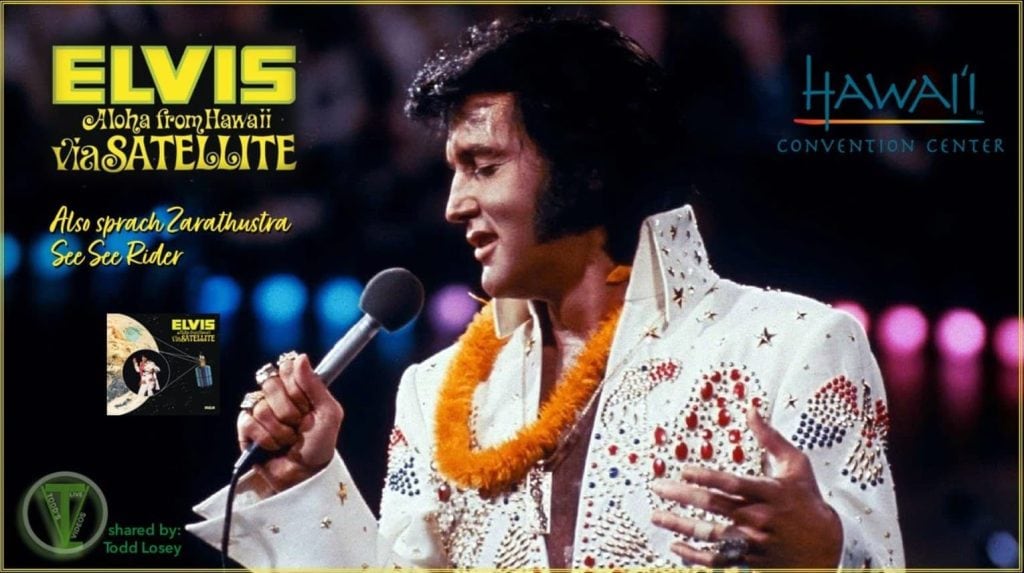
Aloha from Hawaii via Satellite
“Aloha from Hawaii via Satellite” is a landmark concert starring Elvis Presley, which took place at the Honolulu International Center on January 14, 1973. This concert was a significant event as it was broadcast live via satellite to audiences in Asia and Oceania. Due to the time zone differences, the show was presented with a delay in Europe. To address a programming conflict with Super Bowl VII and the fact that “Elvis on Tour” was playing in cinemas, NBC opted to air a ninety-minute television special of the concert on April 4 in the United States.
Elvis Presley had returned to performing tours throughout the United States in 1970, and Colonel Tom Parker, Presley’s manager, was inspired by Richard Nixon’s 1972 visit to China to promote a live broadcast concert featuring Presley. Parker arranged a deal with RCA Records and the NBC network to produce the concert, and the show aimed to benefit the Kui Lee Cancer Fund.
Marty Pasetta produced the program, and a filmed rehearsal concert took place on January 12. The live broadcast earned high ratings in the countries targeted, showcasing Presley’s global popularity. In the United States, the television special became NBC’s highest-rated program of the year and received positive reviews from critics.
The soundtrack album of “Aloha from Hawaii via Satellite” became Elvis Presley’s last chart-topper on Billboard’s album chart. The concert and its associated album are remembered as significant moments in Presley’s career, reflecting his continued influence and popularity on a global scale.
About the Song
“See See Rider,” also known as “C.C. Rider,” “See See Rider Blues,” or “Easy Rider,” is a popular American 12-bar blues song that has become a standard in several genres. Gertrude “Ma” Rainey was the first to record it on October 16, 1924, at Paramount Records in New York. The song’s lyrics tell the story of an unfaithful lover, often referred to as an “easy rider.”
The song is believed to have originated on the black vaudeville circuit and is similar to “Poor Boy Blues” performed by Ramblin’ Thomas. Jelly Roll Morton recalled hearing the song in New Orleans, and Big Bill Broonzy claimed to have learned to play the blues from an itinerant songster named “See See Rider” in the Delta. Lead Belly and Blind Lemon Jefferson also performed the song in the early 20th century.
Ma Rainey’s rendition of “See See Rider” is based on a traditional folk 12-bar blues structure. Lena Arant is credited with the three couplet introduction that explains why the singer is blue. The song has been recorded with variations in stanza patterns, including AAB, ABB, ABA, and AB.
Notable renditions include Ma Rainey’s original recording in 1924, Chuck Willis’s version (as “C.C. Rider”) in 1957, and LaVern Baker’s recording in 1963. Mitch Ryder & the Detroit Wheels, Eric Burdon & the Animals, and Elvis Presley also recorded notable versions of the song. Elvis Presley’s version, recorded in 1970, became his opening song at concerts starting in 1972.
Old Crow Medicine Show included a rendition on their 2004 self-titled album. The song’s enduring popularity has made it a classic in the blues genre.
Video
Lyrics
[Verse 1]
I said see, see, see rider
Oh, see what you have done
I said see, see, see rider
Oh, see what you have done
Oh girl, you made me love you
Now, now, now your loving man has gone
[Chorus]
Hear what I say
[Verse 2]
Well, I’m going away, baby
And I won’t be back till fall
Well, I’m going away baby
And I won’t be back till fall
And if I find me a good girl
I won’t, I won’t be back at all
[Chorus]
Hear what I say, I said
[Outro]
See see rider
Oh see what you have done
Yeah, yeah, yeah